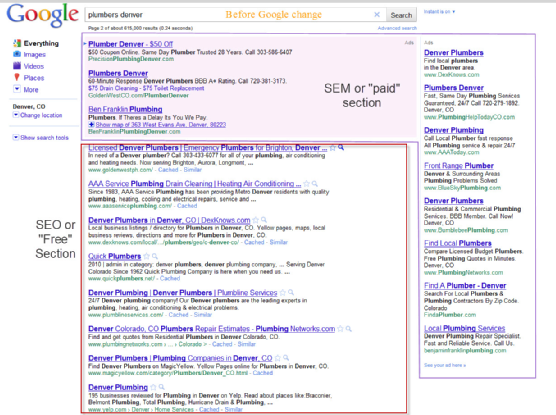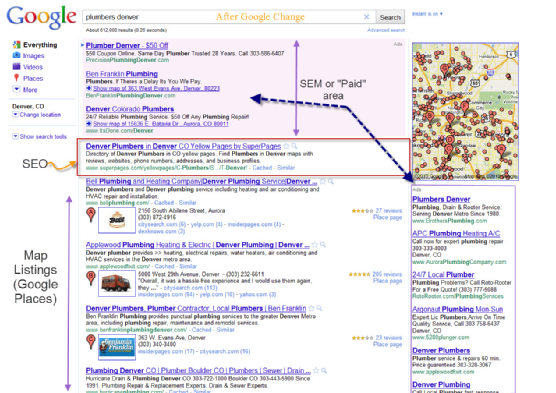Many people confuse or don’t know the difference between the two. I’m going to try to help you understand the pros and cons to both allowing you to make a decision for yourself. SEO (Search Engine Optimization) is located in the main space of the search engine results page and has always been a fundamental goal on initial website construction. Web designers put “meta tags, alt tags, Meta names, content, etc.,” into the site during construction in hopes of making the site show up in the results page in any given engine (Google, Yahoo, Bing). It’s always been a game with the web site designers jockeying for the top position on a few different keyword terms. SEO was dubbed by designers as “Free area of Google!” Make no mistake about it, SEO is not free Though Google doesn’t charge for your listing, the costs associated with your time or a web designers time render “free” fairly expensive..
SEO Pros:
The major advantages to SEO are: Organic listings are generally considered “Trusted,” or at the very least unbiased. In addition to that, there is NO dollar figure assigned to the click value so it can pull more traffic without shutting down. And the last major benefit is that all costs should be paid up front. Lots of debate has ensued about monthly SEO fees, however most SEO companies charge a one time fee.
Cons to SEO:
You have little or no control over the placement of the listing, if it even shows up. The content that each spider or robot looks at can vary greatly from one engine to the other, thus stripping away your control of the optimization process, not to mention that sometimes site design can cause robots not to follow the content correctly.
In November 2010, Google threw another wrench into the SEO process. Google changed the layout of the 1st page of search results in any given search. Google has lessened the amount of SEO locations available on the first page and replaced the listings with Map locations, also known as “Google Places.” (Please see images)
SEM (Search Engine Marketing) also referred to as PPC. SEM appears along the top and right side of the search results page. On the surface is very easy to understand, you pay per click. You don’t need to worry about all the “meta data” with SEM, the only thing that is important is that you have a decent budget you are willing to spend and a decent site to land the customer on. You can do this yourself, but If you decide to do it yourself, beware of a very costly learning curve in how to manage the engine’s Adwords tools. If you hire a professional to do it for you, make sure the company you hire only does internet marketing. Choosing a yellow pages company to manage a SEM program is like asking a veterinarian to perform open heart surgery on you.
SEM Pros:
Paid traffic is very predictable; you pay for the amount you want, and it is done in a very capitalistic way, a bid system. Paid traffic is instant, specific, and relevant. You buy only the terms you want, and you can choose Nationwide exposure or limit it to a 10 mile radius, thus providing “no waste.” Paid positions on the page generally convert at a higher rate and drive a larger sales volume. SEM fits in nicely to the changes Google made to the search results page.
Cons of SEM:
You pay for what you get, stop paying…stop receiving. Conclusion: SEM and SEO play a very large part in the overall plan of “site marketing” and it is up to your business to determine the amount of money to direct to each aspect. I would say from my own stance that both have their place in today’s market, but with the recent changes to Google, SEM is your best bet for the immediate bang.

